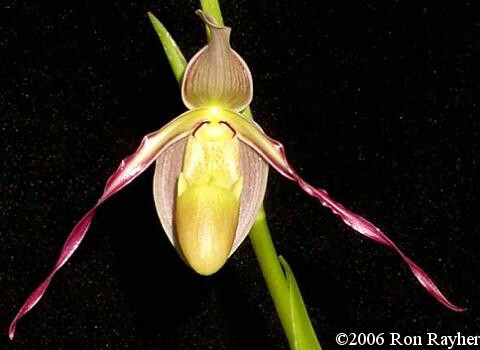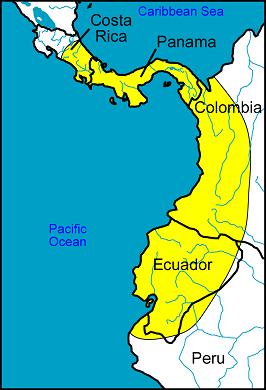

Phragmipedium longifolium (Reichenbach fil. & Warscewicz) Rolfe
- Described: Reichenbach fil. & Warscewicz in Botanische Zeitung, 10: 690 (1852)
- Transferred: Rolfe in Orchid Review, 4: 332 (1896)
- Etymology: Named for the very long leaves of the species.
- Varieties & Forms: A large number of species and varieties related to Phrag. longifolium have been described.
I choose to follow McCook (1989a) in considering Phrag. longifolium to be a single, extremely variable species with a widespread distribution in Central and South America.
- Synonyms:
Selenipedium dariense Reichenbach fil. in Nov. Act. Acad. Cur., 35(2): 8 (1869)
Cypripedium hincksianum Reichenbach fil. in Gardener's Chronicle, n.s., 9: 202 (1878)
Cypripedium longifolium var. gracile Veitch ex Rolfe in Gardener's Chronicle, ? (1890)
Selenipedium reichenbachii Endres in a herbarium sheet in the Reichenbach Herbarium, W15652 and 40322
Cypripedium roezlii Reichenbach fil. ex Regel in Gartenflora 22: 97 (1873)
- Chromosome Count from Atwood (1984) -
- as Phrag. longifolium
| 2n = |
metacentrics |
telocentrics |
n.f. |
| 20 |
18 |
2 |
38 |
- as Phrag. longifolium var. hartwegii
| 2n = |
metacentrics |
telocentrics |
n.f. |
| 20 |
18 |
2 |
36 |
- as Phrag. longifolium var. gracile
| 2n = |
metacentrics |
telocentrics |
n.f. |
| 20 |
18 |
2 |
36 |
- Chromosome Count from Wimber (1983)
- as Phrag. longifolium
| 2n = |
metacentrics |
telocentrics |
n.f. |
| 20 |
-- |
-- |
-- |
- as Phrag. roezlii
| 2n = |
metacentrics |
telocentrics |
n.f. |
| 20 |
-- |
-- |
-- |
- as Phrag. hartwegii
| 2n = |
metacentrics |
telocentrics |
n.f. |
| 22 |
-- |
-- |
-- |
- Chromosome Count from Karasawa (1980) -
- as Phrag. longifolium
| 2n = |
metacentrics |
telocentrics |
n.f. |
| 20 (+3 fragments) |
16 |
4 |
36 |
- as Phrag. hartwegii
| 2n = |
metacentrics |
telocentrics |
n.f. |
| 20 |
16 |
4 |
36 |
- as Phrag. roezlii
| 2n = |
metacentrics |
telocentrics |
n.f. |
| 20 (+2 fragments) |
16 |
4 |
36 |
- as Phrag. longifolium var. gracile
| 2n = |
metacentrics |
telocentrics |
n.f. |
| 20 (+1 fragment) |
16 |
4 |
36 |
Plant Habit (extremely variable)
- Leaves: up to 80 cm long, 1-5 cm wide, dark green
- Inflorescence: 3-14 flowered, unbranched, blooming sequentially, 20-100 cm long, brownish-purple, glabrous or sparsely pubescent
- Bloom: green to yellow-tinted maroon, long-lived, occasionally with a faint daffodil-like odor
- Plant: rhizomes woody, up to 1 cm in diameter
Habitat Data
- Distribution -

- Elevation: sea-level to 1600 m
- Peak Flowering in the Wild: year-round
- Ecology (McCook 1989a): found "on and among rocks along rivers and spray basins of water falls, sometimes below high-water mark. There are coastal populations in Colombia that occur on rocks above high tide and sea spray. In wet forests, it may be found on slopes, disturbed wet road embankments, verticle wet escarpments, and volcanic ash cliffs over rivers. Two populations in Ecuador were in pastures being grazed by horses and cattle." (McCook 1989a), also often found on disturbed sites such as road-cuts.
- Ecology (Snyder 1993): "Finally, we reached an area where moss covered a great boulder in midstream…. While not behind the waterfall, they were constanly misted by the cold spray of falling water. Closer inspection revealed literally hundreds of phragmipediums lining the banks and rock ledges of the stream below. While not strictly lithophytic, these plants seemed to thrive on a thin mat of moist algae and decaying moss that covered the boulders. Although they were thriving in direct sunlight, a never ending blast of moisture-laden air prevented the leaves from dessicating. The fact that these plants were continually watered yet virtually free of fungal rot seemed to go against everything that I knew about orchid culture."
- Mean Temperature Range: known from a variety of temperature ranges, although the plants are often cooled by misting from waterfalls and other fast-moving water sources
- Light: partial sun to light shade
- Medium: mosses and algae covering boulders
- Water: constantly wet
Notes:
- Van Der Cingel (2001): "Phragmipedium longifolium var. hartwegii was observed to be pollinated by Halictine bees of the genera Chlegorella and Caenohalictus (Dodson 1966) and by two species of syrphid flies in western Ecuador."
Sources:
- Atwood, J.T. Jr. "The Relationships of the Slipper Orchids (Subfamily Cypripedioideae, Orchidaceae)." Selbyana 7, no. 2/4 (Aug 1984): 129-247.
- Dressler, R.L. Field Guide to the Orchids of Costa Rica and Panama. Ithaca, NY: Cornell University Press, 1993.
- Flowers, R.W. "Orchids at Fortuna, Panama." American Orchid Society Bulletin 50, no. 8 (Aug 1981): 920-24.
- Garay, L.A. 225 (1). Orchidaceae: Cypripedioideae, Orchidoideae, Neottioideae. Flora of Ecuador, vol. 9, 1978.
- Gruss, O. "A Checklist of the Genus Phragmipedium." Orchid Digest 69, no. 4 (Oct/Dec 2003): 214-41.
- Hernandez, Mariano Ospina. Orquideas Colombianas - Colombian Orchids. Bogota: Publicaciones Tecnicas Ltda., 1958.
- Hooker, J.D. "Cypripedium Longifolium. Native of Central America." Curtis's Botanical Magazine 98 (1872): Tab. 5970. <view article>
- Hooker, J.D. "Cypripedium Roezli. Native of New Grenada." Curtis's Botanical Magazine 102 (1876): Tab. 6217. <view article>
- Karasawa, K. "Karyomorphological Studies in Phragmipedium, Orchidaceae." Bulletin of the Hiroshima Botanical Garden 3 (Dec 1980): 1-49.
- McCook, Lucile M. "Systematics of Phragmipedium (Cypripedioideae; Orchidaceae)," Ph.D. dissertation, Cornell University, 1989a.
- McCook, Lucile M. "The Genus Phragmipedium - Part 1." American Orchid Society Bulletin 58, no. 10 (Nov 1989b): 1095-100.
- McCook, Lucile M. "An Annotated Checklist of the Genus Phragmipedium." Orchid Digest special publication (1998): 1-12.
- Snyder, G. "Phragmipediums in the Mist." American Orchid Society Bulletin 62, no. 9 (Sep. 1993): 890-95.
- Van Der Cingel, N.A. An Atlas of Orchid Pollination. Rotterdam, Netherlands: A.A. Balkema, 2001.
- Williams, L.O. "Flora of Panama. Part III. Fascicle II." Annals of the Missouri Botanical Garden 33, no. 1 (Feb 1946): 1-140.
- Wimber, D.E. "Phragmipedium Cytology - I - Diploidy and Polyploidy in the Hybrids." American Orchid Society Bulletin 52, no. 9 (Sep 1983): 933-39.
Primary Hybrids
| Phrag. longifolium x |
Hybrid |
| besseae |
Eric Young |
| boissierianum |
Praying Mantis |
| caricinum |
Conchiferum |
| caudatum |
Grande |
| czerwiakowianum |
Dennis Kleinbach |
| dalessandroi |
Nicholle Tower |
| kaieteurum |
Memoria Ed Murphy |
| lindenii |
Macrochilum |
| lindleyanum |
Urgandiae |
| pearcei |
Green Hornet |
| richteri |
Grassau |
| sargentianum |
Sorcerer's Apprentice |
| schlimii |
Sedenii |
| vittatum |
Arthur |
| wallisii |
Paul Eugene Conroy |
| warscewiczianum |
Wössner Supergrande |
Return to the Data Sheets Page
Page Created By: Stephen Manza
Last Updated: 8-16-06
contact: silence882@gmail.com



